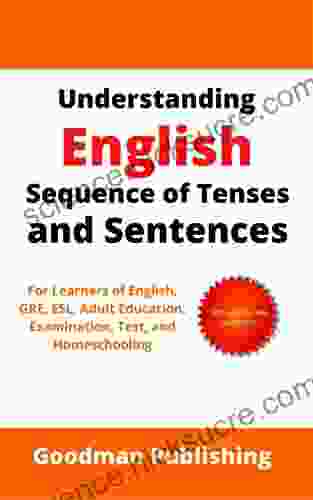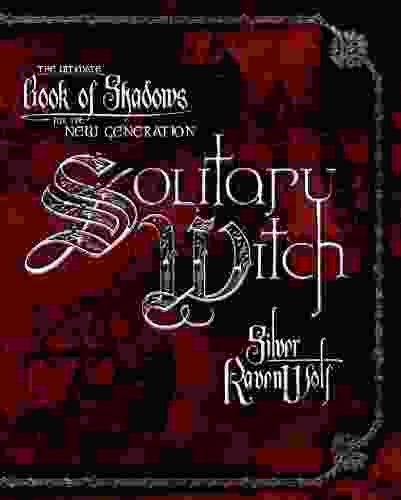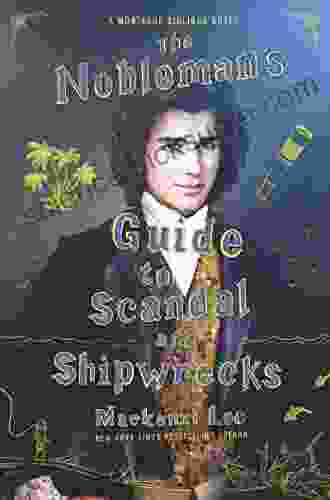Understanding the English Sequence of Tenses and Sentences

In the intricate tapestry of English grammar, the sequence of tenses and sentences plays a pivotal role in conveying meaning and maintaining coherence. Understanding this sequence is crucial for effective communication, both written and spoken. This comprehensive article delves into the complexities of English tense and sentence structure, empowering you to express yourself with clarity and precision.
Tense in English
Tense refers to the time frame of an action or event. English grammar employs three main tenses: present, past, and future. Each tense has its own set of verb forms, which indicate the time of the action in relation to the speaker's present moment.
4 out of 5
| Language | : | English |
| File size | : | 401 KB |
| Text-to-Speech | : | Enabled |
| Screen Reader | : | Supported |
| Enhanced typesetting | : | Enabled |
| Print length | : | 32 pages |
| Lending | : | Enabled |
Present Tense
The present tense is used to describe actions or events that are happening now or are habitual in nature. It can also be used to express general truths or states of being. Examples of present tense verbs include "write," "speak," and "believe."
Past Tense
The past tense is used to describe actions or events that happened at a specific time in the past. Regular verbs form the past tense by adding "-ed" to the base form (e.g., "played"). Irregular verbs have their own unique past tense forms (e.g., "ran").
Future Tense
The future tense is used to describe actions or events that will happen in the future. It can be formed using the modal verb "will" followed by the base form of the verb (e.g., "will write"). Alternatively, the present progressive tense can be used to express future events that are already planned or arranged (e.g., "am writing").
Sequence of Tenses
The sequence of tenses refers to the appropriate use of different tenses to maintain logical relationships between events. When multiple actions occur in a sequence, the tenses must reflect the chronological order.
Consistency of Tense
As a general rule, it is advisable to maintain consistency of tense within a sentence or paragraph. This means that if you start a sentence in a particular tense, you should continue using that tense throughout the sentence. However, there are exceptions to this rule, which will be discussed later.
Historical Present
The historical present is a technique used to describe past events in the present tense. This technique helps to create a sense of immediacy and engagement for the reader or listener. For example:
"In 1861, the American Civil War erupts, pitting brother against brother."
Sequence of Past Tenses
When describing a series of past events, it is important to use the correct sequence of past tenses:
- Simple past tense: for actions that happened at a specific time in the past
- Past progressive tense: for actions that were happening at a particular time in the past
- Past perfect tense: for actions that had finished before another action in the past
Sequence of Future Tenses
The sequence of future tenses is similar to the sequence of past tenses:
- Simple future tense: for actions that will happen in the future
- Future progressive tense: for actions that will be happening at a particular time in the future
- Future perfect tense: for actions that will have finished before another action in the future
Sentence Structure
In addition to tense, the structure of sentences plays a significant role in conveying meaning and building logical relationships. English sentences typically follow a subject-verb-object (SVO) word order.
Sentence Parts
The main parts of a sentence include:
- Subject: the noun or pronoun that performs the action of the verb
- Verb: the action or state of being
- Object: the noun or pronoun that receives the action of the verb
- Complement: additional information that completes the sentence
Sentence Types
There are four basic types of sentences based on their structure and function:
- Declarative: makes a statement
- Interrogative: asks a question
- Imperative: gives a command or instruction
- Exclamatory: expresses strong emotion
Complex Sentences
Complex sentences contain multiple clauses, which are groups of words that contain a subject and a verb. Clauses are connected by subordinating conjunctions (e.g., because, although, when). Complex sentences can be used to express complex relationships between ideas.
Sentence Analysis
Understanding the structure of sentences is essential for effective communication. By breaking down sentences into their component parts, you can analyze their meaning and identify any errors or inconsistencies.
Mastering the sequence of tenses and sentences in English grammar is a transformative skill that unlocks the power to communicate with clarity and precision. By understanding the nuances of tense and sentence structure, you can express your thoughts and ideas effectively in both written and spoken form. Remember to apply these principles consistently, and you will become a confident and proficient user of the English language.
4 out of 5
| Language | : | English |
| File size | : | 401 KB |
| Text-to-Speech | : | Enabled |
| Screen Reader | : | Supported |
| Enhanced typesetting | : | Enabled |
| Print length | : | 32 pages |
| Lending | : | Enabled |
Do you want to contribute by writing guest posts on this blog?
Please contact us and send us a resume of previous articles that you have written.
 Fiction
Fiction Non Fiction
Non Fiction Romance
Romance Mystery
Mystery Thriller
Thriller SciFi
SciFi Fantasy
Fantasy Horror
Horror Biography
Biography Selfhelp
Selfhelp Business
Business History
History Classics
Classics Poetry
Poetry Childrens
Childrens Young Adult
Young Adult Educational
Educational Cooking
Cooking Travel
Travel Lifestyle
Lifestyle Spirituality
Spirituality Health
Health Fitness
Fitness Technology
Technology Science
Science Arts
Arts Crafts
Crafts DIY
DIY Gardening
Gardening Petcare
Petcare Tina Dreffin
Tina Dreffin Kai Nacke
Kai Nacke Howard Greene
Howard Greene John T Hansen
John T Hansen John Bird
John Bird Jonathan White
Jonathan White Jim Steenburgh
Jim Steenburgh Morgan Lyle
Morgan Lyle Sophia Joy
Sophia Joy Michael Miller
Michael Miller Aphra Behn
Aphra Behn David F Kelly
David F Kelly Timm Woods
Timm Woods George M Fredrickson
George M Fredrickson Lexie Scott
Lexie Scott Bruce J Macfadden
Bruce J Macfadden Len Sperry
Len Sperry Emeran Mayer
Emeran Mayer Jon Emmett
Jon Emmett Robert Heidler
Robert Heidler Noha Mellor
Noha Mellor Ron L Deal
Ron L Deal Gina Guddat
Gina Guddat Benjamin Johnston
Benjamin Johnston Kardas Publishing
Kardas Publishing Andrew Jamieson
Andrew Jamieson Ken Schultz
Ken Schultz Roy Dittmann
Roy Dittmann David Crabtree
David Crabtree Marc M Triola
Marc M Triola Alaina Talboy
Alaina Talboy Alastair Humphreys
Alastair Humphreys Alana Chernila
Alana Chernila Scott Surovich
Scott Surovich Nicholas Romanov
Nicholas Romanov Jack Nicklaus
Jack Nicklaus Jacqueline Fitzpatrick
Jacqueline Fitzpatrick Harriet Brown
Harriet Brown Alan Garner
Alan Garner Aja Raden
Aja Raden Clint Emerson
Clint Emerson J R Haseloff
J R Haseloff Donna Morang
Donna Morang Dorothy H Crawford
Dorothy H Crawford Billy Walsh
Billy Walsh Marsha Wenig
Marsha Wenig Sam J Fires
Sam J Fires Shaun Tomson
Shaun Tomson Alana Mclaren
Alana Mclaren Graham Bower
Graham Bower Dmitry Zinoviev
Dmitry Zinoviev Frances E Jensen
Frances E Jensen Robert E Stake
Robert E Stake Michael Freedland
Michael Freedland Bill Parisi
Bill Parisi John Muir
John Muir Francesca Lia Block
Francesca Lia Block Penney Peirce
Penney Peirce Meredith Marsh
Meredith Marsh Dennis Jarecke
Dennis Jarecke Eden O Neill
Eden O Neill Edward A Tiryakian
Edward A Tiryakian Charles J Thayer
Charles J Thayer Michael Domican
Michael Domican Gary Smith
Gary Smith Lex Croucher
Lex Croucher Elizabeth Thompson
Elizabeth Thompson Daniel C Okpara
Daniel C Okpara Bryan Mann
Bryan Mann Dr Joseph Parent
Dr Joseph Parent Kim Stanley Robinson
Kim Stanley Robinson Carol Tuttle
Carol Tuttle Amelia Simmons
Amelia Simmons Ainsley Arment
Ainsley Arment Bill Friedrich
Bill Friedrich Christopher Willard
Christopher Willard Po Bronson
Po Bronson Steven H Strogatz
Steven H Strogatz David A Sousa
David A Sousa Zita West
Zita West Farlex International
Farlex International Jordon Greene
Jordon Greene Aidan Comerford
Aidan Comerford I Johnson
I Johnson Caitlin Zaloom
Caitlin Zaloom Mel Thompson
Mel Thompson Rehana Jawadwala
Rehana Jawadwala Madeline Milne
Madeline Milne Snap Summaries
Snap Summaries Dusty Rhodes
Dusty Rhodes Patrick O Sullivan
Patrick O Sullivan Andrea Travillian
Andrea Travillian Rene D Zweig
Rene D Zweig Marcus Chown
Marcus Chown Barbara Oehlberg
Barbara Oehlberg Jakob Tanner
Jakob Tanner Rebecca Jones
Rebecca Jones Alan E Sparks
Alan E Sparks Anders Halverson
Anders Halverson Alan Murchison
Alan Murchison Jill Homer
Jill Homer Alice Oseman
Alice Oseman David Roberts
David Roberts Michael D Rich
Michael D Rich Kate Bettison
Kate Bettison Amy Edelstein
Amy Edelstein Pavel Tsatsouline
Pavel Tsatsouline Emily Harris Adams
Emily Harris Adams Aileen Erin
Aileen Erin Jonathan Gottschall
Jonathan Gottschall Helen Palmer
Helen Palmer Anthonissa Moger
Anthonissa Moger Tonya Johnston
Tonya Johnston Michal Stawicki
Michal Stawicki Jackson Katz
Jackson Katz Jessica Cornwell
Jessica Cornwell Belinda Luscombe
Belinda Luscombe Shoshana Levin Fox
Shoshana Levin Fox Michael Sidgwick
Michael Sidgwick Contractor Education Inc
Contractor Education Inc Clyde Fitch
Clyde Fitch Theodore P Jorgensen
Theodore P Jorgensen Jeanne Faulkner
Jeanne Faulkner Kidada Jones
Kidada Jones Dave Whitson
Dave Whitson Steven Trimble
Steven Trimble Rob Casey
Rob Casey Miles Mckenna
Miles Mckenna Kerry Diamond
Kerry Diamond Bob Mayer
Bob Mayer Jessica Cunsolo
Jessica Cunsolo Juliet Marillier
Juliet Marillier Sandy Lindsey
Sandy Lindsey Cindy Hudson
Cindy Hudson Lisa Newton
Lisa Newton Tenth Edition Revised Kindle Edition
Tenth Edition Revised Kindle Edition Alan Rouse
Alan Rouse David Jason
David Jason John H Moore
John H Moore John Riley
John Riley Nassim Nicholas Taleb
Nassim Nicholas Taleb Al Marlowe
Al Marlowe Jon Tyson
Jon Tyson William A Kaplin
William A Kaplin Linda Welters
Linda Welters Sara Hanover
Sara Hanover Aimee Aristotelous
Aimee Aristotelous Trevor Lund
Trevor Lund Shing Tung Yau
Shing Tung Yau Judith Garrard
Judith Garrard Magnus Thollander
Magnus Thollander Amanda Ford
Amanda Ford Deborah Harkness
Deborah Harkness Toby Wilkinson
Toby Wilkinson Cat Warren
Cat Warren James A Michener
James A Michener Melinda Rushe
Melinda Rushe Martin Rooney
Martin Rooney Michael W King
Michael W King Charlotte Markey
Charlotte Markey Christopher Scordo
Christopher Scordo Erin Lovelace
Erin Lovelace Kevin Williams
Kevin Williams Hope Smith
Hope Smith Dr Guy Leschziner
Dr Guy Leschziner Olivia Gentile
Olivia Gentile Matthew Sturm
Matthew Sturm Vera Nazarian
Vera Nazarian Brian Mills
Brian Mills Peg Tyre
Peg Tyre Stephen M Camarata
Stephen M Camarata Janice Selekman
Janice Selekman Kiku Hughes
Kiku Hughes David Vine
David Vine Saul Rip
Saul Rip Edupan7 Publishing
Edupan7 Publishing Michael Shermer
Michael Shermer Bruce Lee
Bruce Lee Anne Enright
Anne Enright Nick Lyons
Nick Lyons Helena Clare
Helena Clare Judy Jewell
Judy Jewell G E R Lloyd
G E R Lloyd Robert M Emerson
Robert M Emerson Gregory J Davenport
Gregory J Davenport Lisa Kenney
Lisa Kenney Erin Ekins
Erin Ekins Stephen Wolfram
Stephen Wolfram Kerstin Gier
Kerstin Gier Michael Morpurgo
Michael Morpurgo Paul G Schempp
Paul G Schempp Mike Warren
Mike Warren Gail Tully
Gail Tully Alan Burdick
Alan Burdick Jay Annelli
Jay Annelli Chris Vines
Chris Vines Jessica Battilana
Jessica Battilana Dan Dipiro
Dan Dipiro Original Edition Kindle Edition
Original Edition Kindle Edition Kelly Jensen
Kelly Jensen Brandy Roon
Brandy Roon Wayne Stewart
Wayne Stewart Markus Rex
Markus Rex Robert A Sadowski
Robert A Sadowski Beata Bliss Lewis Md
Beata Bliss Lewis Md Christopher Gavigan
Christopher Gavigan Ann Hagedorn
Ann Hagedorn Skeleton Steve
Skeleton Steve Andrew Blum
Andrew Blum Anna Hickey Moody
Anna Hickey Moody Andy Zipser
Andy Zipser Dean Burnett
Dean Burnett Dimitri Loose
Dimitri Loose Samuel Carbaugh
Samuel Carbaugh James Witts
James Witts Princess Her
Princess Her Joe Bertagna
Joe Bertagna Layla Moon
Layla Moon Antipodean Writer
Antipodean Writer Cynthia Clumeck Muchnick
Cynthia Clumeck Muchnick Thubten Chodron
Thubten Chodron Constance Classen
Constance Classen Rosemarie Anderson
Rosemarie Anderson Doug Gelbert
Doug Gelbert Vanessa Ogle
Vanessa Ogle Al Pasha
Al Pasha Alan Vermilye
Alan Vermilye Al Barkow
Al Barkow Gavin Francis
Gavin Francis Steven Horak
Steven Horak Bob Plott
Bob Plott Lecile Harris
Lecile Harris Lauren Blackwood
Lauren Blackwood Jeff Maynard
Jeff Maynard Massad Ayoob
Massad Ayoob James Willard Schultz
James Willard Schultz Peter Ballingall
Peter Ballingall Howard Maxwell
Howard Maxwell Alan Lawrence Sitomer
Alan Lawrence Sitomer Vernon Coleman
Vernon Coleman Gayle Peterson
Gayle Peterson Natazha Raine O Connor
Natazha Raine O Connor E A Koetting
E A Koetting Martin J Pring
Martin J Pring Mark Drolsbaugh
Mark Drolsbaugh Megan Gray Md
Megan Gray Md Taquetta Baker
Taquetta Baker Kareem Abdul Jabbar
Kareem Abdul Jabbar Mackenzi Lee
Mackenzi Lee Howard Hill
Howard Hill Chris Bowers
Chris Bowers Matt Mosher
Matt Mosher George Plimpton
George Plimpton Lee Carroll
Lee Carroll John Leo
John Leo Jay Speight
Jay Speight Matthew Mcbee
Matthew Mcbee Mike Rothschild
Mike Rothschild Aidan Dodson
Aidan Dodson Jane P Gardner
Jane P Gardner Isabella Morris
Isabella Morris Joanne Webb
Joanne Webb Katharine Graves
Katharine Graves Rose Lynn Fisher
Rose Lynn Fisher Alan Margot
Alan Margot Ged Jenkins Omar
Ged Jenkins Omar Habeeb Quadri
Habeeb Quadri George Knudson
George Knudson Akil Palanisamy
Akil Palanisamy S Connolly
S Connolly J Zoltan
J Zoltan Margaret J Wheatley
Margaret J Wheatley John J Miller
John J Miller Jamie Baulch
Jamie Baulch Alan Porter
Alan Porter Courtney Macavinta
Courtney Macavinta Teresa Mccallum
Teresa Mccallum Linda G Morris
Linda G Morris Brenda Nathan
Brenda Nathan George Monbiot
George Monbiot Thomas Kurz
Thomas Kurz Dave Heller
Dave Heller Catherine Belknap
Catherine Belknap Zondervan
Zondervan Leigh Sales
Leigh Sales Kristine Barnett
Kristine Barnett Angelina Wilson
Angelina Wilson Louis Schubert
Louis Schubert Margit Ystanes
Margit Ystanes Jenni Hicks
Jenni Hicks M K Hume
M K Hume Alan Lightman
Alan Lightman 12th Edition Kindle Edition
12th Edition Kindle Edition Ken Denmead
Ken Denmead Steve Michalik
Steve Michalik Amye Archer
Amye Archer Alan C Acock
Alan C Acock Barbara Scott
Barbara Scott John Irving
John Irving Jan Smith
Jan Smith John Feinstein
John Feinstein Jane Bottomley
Jane Bottomley S A Klopfenstein
S A Klopfenstein Ndeye Labadens
Ndeye Labadens Michael Gray
Michael Gray We Fairbairn
We Fairbairn Al Sweigart
Al Sweigart Rand Cardwell
Rand Cardwell Sonia Nazario
Sonia Nazario Jacqueline Church Simonds
Jacqueline Church Simonds Alan Booth
Alan Booth Steve Moore
Steve Moore Alice Scordato
Alice Scordato Joe Berardi
Joe Berardi Carla Schroder
Carla Schroder Akwaeke Emezi
Akwaeke Emezi Andy Adams
Andy Adams Gordon R Dickson
Gordon R Dickson Larry Wasserman
Larry Wasserman Bianca Smith
Bianca Smith Anne Dachel
Anne Dachel Alan Graham
Alan Graham Gary R Varner
Gary R Varner Al Macy
Al Macy Melissa Bashardoust
Melissa Bashardoust Celeste Jones
Celeste Jones Vasilis Konstantinos Giontzis
Vasilis Konstantinos Giontzis Lj Andrews
Lj Andrews Jill Stamm
Jill Stamm Jane Poynter
Jane Poynter Al Roker
Al Roker Robert L Kelly
Robert L Kelly Christos A Djonis
Christos A Djonis Amelia Mayer
Amelia Mayer Lisa Marasco
Lisa Marasco Nina Lacour
Nina Lacour Frank E Harrell Jr
Frank E Harrell Jr Mike Martin
Mike Martin The Rogue Hypnotist
The Rogue Hypnotist Aileen Evans
Aileen Evans David King
David King Esther Parry
Esther Parry Carl Gustav Jung
Carl Gustav Jung Karen Levin Coburn
Karen Levin Coburn Leif K Karlsen
Leif K Karlsen Hannah Ewens
Hannah Ewens Helen Hollick
Helen Hollick Deitra Leonard Lowdermilk
Deitra Leonard Lowdermilk Alan S Kaufman
Alan S Kaufman Terry L Duran
Terry L Duran Anahad O Connor
Anahad O Connor Pallas Snider
Pallas Snider Paramahansa Yogananda
Paramahansa Yogananda Gary Player
Gary Player United States Government Us Marine Corps
United States Government Us Marine Corps Dawn Sakamoto Paiva
Dawn Sakamoto Paiva Alex Light
Alex Light Celeste Headlee
Celeste Headlee Noel St Clair
Noel St Clair Jay Revell
Jay Revell Julie Bradley
Julie Bradley Alan Hearnshaw
Alan Hearnshaw Collins Easy Learning
Collins Easy Learning Mista Nove
Mista Nove Truman Everts
Truman Everts Vishwesh Bhatt
Vishwesh Bhatt Christopher Hellman
Christopher Hellman Mark Booth
Mark Booth Dr David Geier
Dr David Geier Sheila Barton
Sheila Barton Conor Daly
Conor Daly Mendocino Press
Mendocino Press Damon Lee
Damon Lee Roxy And Ben Dawson
Roxy And Ben Dawson Robert Macfarlane
Robert Macfarlane William Harding
William Harding Dylan Alcott
Dylan Alcott Publishdrive Edition Kindle Edition
Publishdrive Edition Kindle Edition G H Hardy
G H Hardy Josh Kilmer Purcell
Josh Kilmer Purcell Laurie Pickard
Laurie Pickard Martin Erwig
Martin Erwig Percy Boomer
Percy Boomer Elaine Howard Ecklund
Elaine Howard Ecklund William Foote Whyte
William Foote Whyte Kate Brian
Kate Brian Aitzaz Imtiaz
Aitzaz Imtiaz Jay H Lefkowitch
Jay H Lefkowitch Micky Ward
Micky Ward Mykel Hawke
Mykel Hawke Ahmed Osman
Ahmed Osman Don Casey
Don Casey Tod E Bolsinger
Tod E Bolsinger Hiro Ainana
Hiro Ainana Al Ristori
Al Ristori Florence Williams
Florence Williams Tim Gallagher
Tim Gallagher Alfred S Posamentier
Alfred S Posamentier Gary B Ferngren
Gary B Ferngren Douglas T Hall
Douglas T Hall Molly Absolon
Molly Absolon Peter Irvine
Peter Irvine Bradley Efron
Bradley Efron Jeremy Miles
Jeremy Miles Terry Funk
Terry Funk Daphne Rose Kingma
Daphne Rose Kingma Joyce Burkhalter Flueckiger
Joyce Burkhalter Flueckiger Nancy Hughes
Nancy Hughes Hervey Garrett Smith
Hervey Garrett Smith Jacob K Olupona
Jacob K Olupona Erica Westly
Erica Westly Timothy C Smith
Timothy C Smith Hammad Fozi
Hammad Fozi Michael Casey
Michael Casey Betsy Tobin
Betsy Tobin Douglas Noll
Douglas Noll Bettina Gordon Wayne
Bettina Gordon Wayne Arthur Fleischmann
Arthur Fleischmann Kiersten White
Kiersten White Richard Pears
Richard Pears Jerry Robeson
Jerry Robeson Alan S Gurman
Alan S Gurman Chris Klug
Chris Klug Letisha Galloway
Letisha Galloway James F Boswell
James F Boswell Kevin B Shearer
Kevin B Shearer Ai Publishing
Ai Publishing Mark Occhilupo
Mark Occhilupo Gillian Gill
Gillian Gill Terry Breverton
Terry Breverton Stephanie Izard
Stephanie Izard Pantea Kalhor
Pantea Kalhor Jerry Robertson
Jerry Robertson Al Owens
Al Owens Martin Luther King Jr
Martin Luther King Jr Ilan Dvir
Ilan Dvir Mariam N Ottimofiore
Mariam N Ottimofiore Lo Bosworth
Lo Bosworth Craig Childs
Craig Childs Mark Harris
Mark Harris Gordon H Orians
Gordon H Orians Alan Watts
Alan Watts Takuan Soho
Takuan Soho Al Strachan
Al Strachan Sarah Hendrickx
Sarah Hendrickx Will Storr
Will Storr Harold Klemp
Harold Klemp Nick Hughes
Nick Hughes Al Yellon
Al Yellon Bill Walker
Bill Walker Denise Alvarado
Denise Alvarado Rick Bass
Rick Bass Spencer Wells
Spencer Wells Suze Guillaume
Suze Guillaume Tom Shachtman
Tom Shachtman Mark Goulston
Mark Goulston Satya Sundar Sethy
Satya Sundar Sethy Jacqueline Tourville
Jacqueline Tourville Douglas G Altman
Douglas G Altman Donald Woods Winnicott
Donald Woods Winnicott W E Fairbairn
W E Fairbairn Gill Rapley
Gill Rapley E Cheng
E Cheng Lingo Mastery
Lingo Mastery Joe Clement
Joe Clement Franz Metcalf
Franz Metcalf George Buehler
George Buehler Sir Edmund Hillary
Sir Edmund Hillary Robin Mckinley
Robin Mckinley David D Burns
David D Burns Janet Houser
Janet Houser Bryon Powell
Bryon Powell Sara Wickham
Sara Wickham Alan Shipnuck
Alan Shipnuck Rebekah Sack
Rebekah Sack Alan E Kazdin
Alan E Kazdin Orson Scott Card
Orson Scott Card Eddy Starr Ancinas
Eddy Starr Ancinas Peter Hathaway Capstick
Peter Hathaway Capstick Bobby Flay
Bobby Flay Arnold Haultain
Arnold Haultain Yang Jwing Ming
Yang Jwing Ming Thomas Metzinger
Thomas Metzinger Susan B Lovejoy
Susan B Lovejoy Alan Gelb
Alan Gelb Aidan Chambers
Aidan Chambers James Gleick
James Gleick Arnold Yates
Arnold Yates Albert Einstein
Albert Einstein Aileen Nielsen
Aileen Nielsen George E Andrews
George E Andrews Andre Agassi
Andre Agassi Grace Lebow
Grace Lebow Kevin Hunter
Kevin Hunter Alan R Hall
Alan R Hall Samuel N Rosenberg
Samuel N Rosenberg Nilakantasrinivasan J Neil
Nilakantasrinivasan J Neil Charles B White
Charles B White Juno Roche
Juno Roche Andrew Rowe
Andrew Rowe Mary Basick
Mary Basick Aiva Books
Aiva Books R A Salvatore
R A Salvatore Al Desetta M A
Al Desetta M A
Light bulbAdvertise smarter! Our strategic ad space ensures maximum exposure. Reserve your spot today!
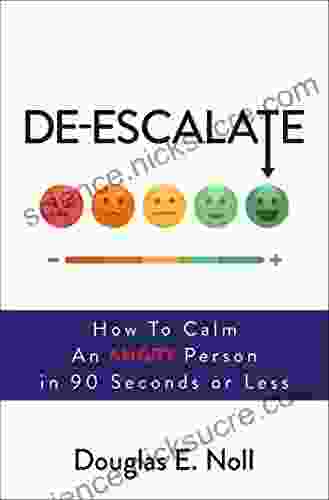
 Bernard PowellHow to Calm an Angry Person in 90 Seconds or Less: Proven Techniques for...
Bernard PowellHow to Calm an Angry Person in 90 Seconds or Less: Proven Techniques for...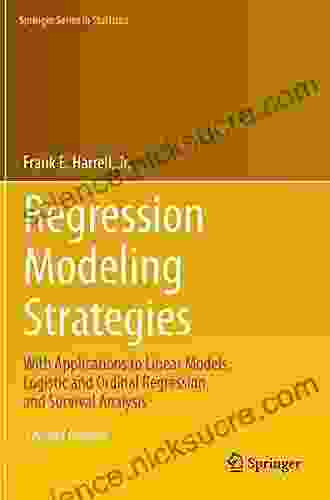
 Jake CarterGeneralized Linear Models: With Applications to Linear Models, Logistic and...
Jake CarterGeneralized Linear Models: With Applications to Linear Models, Logistic and... Gabriel Garcia MarquezFollow ·17.7k
Gabriel Garcia MarquezFollow ·17.7k Ervin BellFollow ·18.6k
Ervin BellFollow ·18.6k Hunter MitchellFollow ·8k
Hunter MitchellFollow ·8k Jake PowellFollow ·16k
Jake PowellFollow ·16k Jaylen MitchellFollow ·11.1k
Jaylen MitchellFollow ·11.1k Jerome BlairFollow ·14.3k
Jerome BlairFollow ·14.3k Fabian MitchellFollow ·15.2k
Fabian MitchellFollow ·15.2k Fyodor DostoevskyFollow ·8.6k
Fyodor DostoevskyFollow ·8.6k

 Deacon Bell
Deacon BellCompilation of Short Stories on Mental Illness and Ways...
Mental illness is a serious issue that affects...
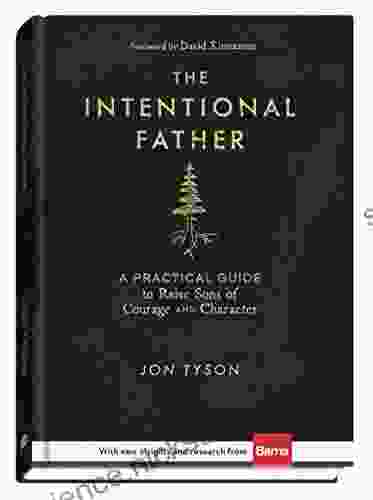
 Jonathan Hayes
Jonathan HayesThe Practical Guide to Raising Courageous and...
As parents, we all want...

 Carlos Fuentes
Carlos FuentesA Journey to Remember: The High Sierra Love Story of...
Prologue: A Wilderness Encounter Beneath...
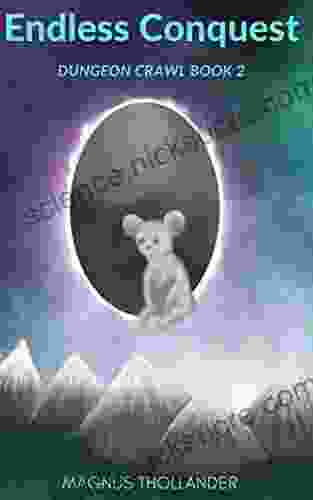
 Douglas Foster
Douglas FosterEndless Conquest: Embark on an Immersive Dungeon Crawl in...
Endless Conquest is a captivating LitRPG...
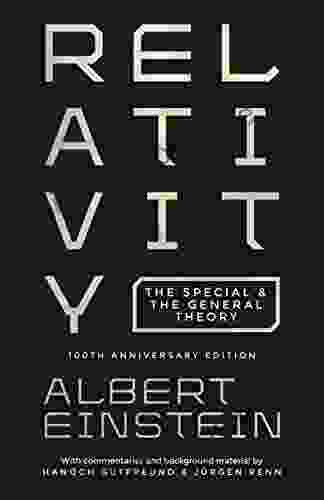
 Caleb Long
Caleb LongThe Special and the General Theory 100th Anniversary...
The year 2015 marks a...
4 out of 5
| Language | : | English |
| File size | : | 401 KB |
| Text-to-Speech | : | Enabled |
| Screen Reader | : | Supported |
| Enhanced typesetting | : | Enabled |
| Print length | : | 32 pages |
| Lending | : | Enabled |


